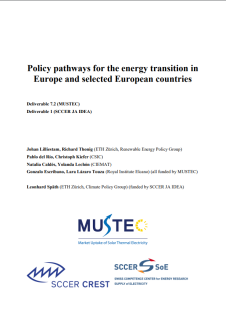
In a decarbonised future electricity system, Europe will rely on fluctuating renewable sources, such as solar PV and wind power, to a much larger extent than today. This means that Europe as a whole and each individual country on the continent must increase the availability and use of flexibility options in order to balance the grid. Such flexibility options include dispatchable renewable sources (e.g. concentrating solar power (CSP) with thermal storage, or dam hydropower), electricity storage, and demand-response.
This report is a first step towards identifying the potential future role for dispatchable renewables - specifically CSP (MUSTEC project) and dam hydropower (SCCER JA IDEA project) - as a function of policy decisions that either increase the need for flexibility (e.g. fluctuating renewables) or provide flexibility (e.g. storage, dispatchable renewables, flexible demand).
The report examines clean energy policy strategies in France, Germany, Spain, Italy, Switzerland and of the European Union as a whole, drawing on an energy transition logics framework that distinguishes three policy "logics" - state-centred logic, in which the central government leads or carries out the transition; market-centred logic, in which the government sets the framework but leaves all other decisions to market actors; and grassroots-centred logic, in which the transition is carried out locally with the resources available to each community - and considers energy transition strategies as a constellation of these "logics".
The findings show that all countries and the EU as a whole seek to strongly decarbonise their power systems, but that no dominant policy pathway foresees decarbonisation to the extent required to fulfil the European (Union and national) commitments under the Paris Agreement. It also shows that while all countries seek to vastly expand intermittent renewables, no policy pathway is specific about how it will provide flexibility, especially not at the scale and pace needed. This problem will be exacerbated as fossil fuels are phased out – first coal and lignite (mainly in the 2020s) and later gas power (especially in the 2040s) – at which point the European power system(s) will lose much of its current flexibility. Unless other, carbon-free flexibility options are expanded, ther report finds that it will be increasingly difficult to maintain power system stability.
